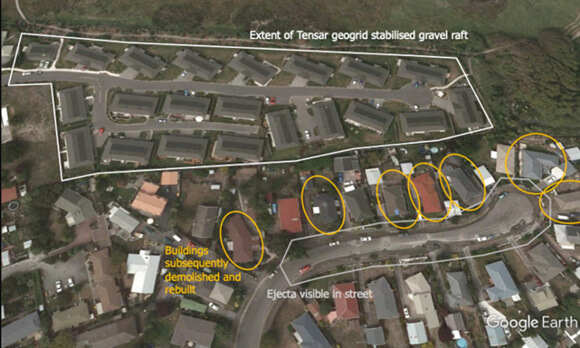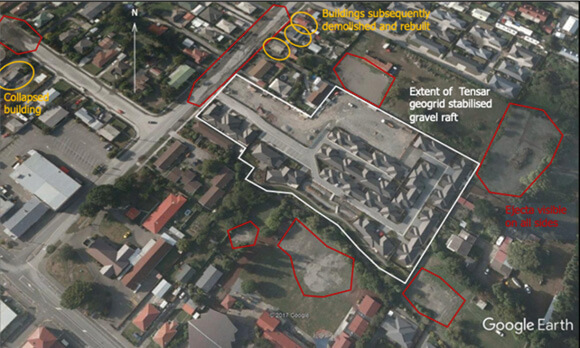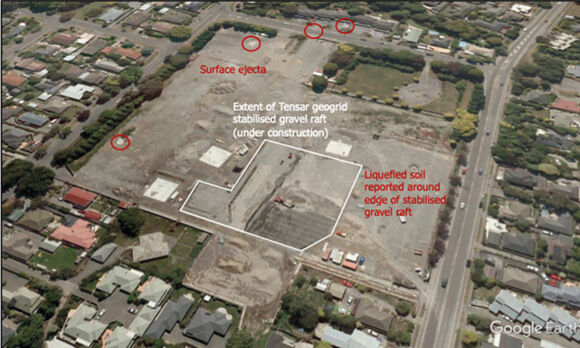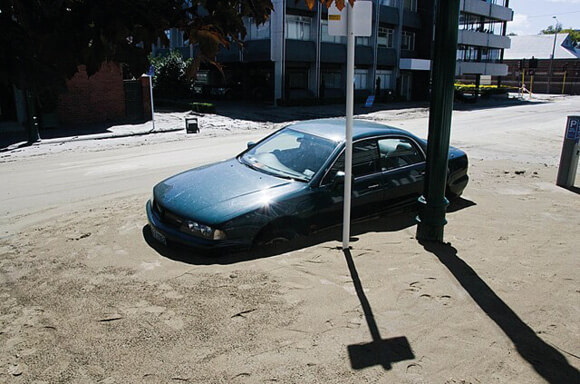Soil Liquefaction: Causes, Effects, and Solutions
Soil liquefaction can occur when saturated or partially saturated loose sands experience a loss of strength and stiffness under the repeated application of a large load, such as during an earthquake. The cyclic stress causes a rapid increase in pore water pressure, which decreases soil strength. Under these conditions, the sand begins to flow like a liquid.
The potentially devastating effects of soil liquefaction were thrown into sharp relief by the 2011 Christchurch earthquake in New Zealand: substantial liquefaction took place, producing 400,000 tons of silt, causing widespread damage to the city, and tragically killing 185 people.
Even before, and especially since this natural disaster, many construction projects built on liquefiable ground have included special measures to mitigate against soil liquefaction. For example, geotechnical engineers can construct mechanically stabilised gravel rafts using geogrids, which increase the soil bearing capacity and limit structural damage.
Written by specialist geotechnical engineer, Andrew Lees, this guide offers a deep dive into soil liquefaction. Read on to discover more about the causes, effects, solutions, and more. There’s plenty of ground to cover here, so if you’re looking for something in particular, use the links below to navigate straight to it:
- What is soil liquefaction?
- Is soil liquefaction dangerous?
- The causes of soil liquefaction
- Types of soil liquefaction
- How to mitigate soil liquefaction: case studies from Tensar
Tensar has designed and delivered many to reduce the potential impact of soil liquefaction on buildings and other structures. If this could be of use for your upcoming project, speak to our team today.
What is soil liquefaction?
Soil liquefaction is the temporary loss of strength and stiffness that results in normally solid soil behaving as a liquid. It can be observed in saturated, unconsolidated soils, particularly in areas impacted by seismic S waves (secondary waves) from earthquakes.
Liquefaction results in soil bearing capacity failure and shear-induced settlement on the edges of buildings and structures; this causes curvature of the foundation and can lead to structural damage and, in the most extreme cases, collapse. Where retaining wall systems are involved, settlement of the retained soil can induce tilting or sliding in the structure. If you are interested in discovering different types of retaining walls, read our guide: Retaining Walls: Types, Designs, and Functions
Fortunately, there are design tools we can use to limit the impact of liquefaction on buildings and other structures – jump ahead to the section on mitigating building damage to discover more.
Car in liquefaction mud, Christchurch 2011 (Source: Wikimedia Commons)
Is soil liquefaction dangerous?
The potential danger posed by soil liquefaction should not be underestimated, and the Indonesia 2018 tsunami and earthquake serves as a stark reminder. During this natural disaster, liquefaction and the associated mudflows not only led to the collapse of numerous buildings but were also linked to the deaths of more than 1,200 people.
The causes of soil liquefaction
Soil liquefaction is caused by the ground shaking during earthquakes. A cyclic load applied to loose, water-logged soil close to the surface rapidly increases pore water pressure, reducing the soil’s strength and stiffness. This, in turn, makes it behave like a liquid.
Let’s unpack this process in more detail. Loose materials, such as sands and silts, compress when a load is applied. In saturated soils, water fills the gaps between the soil particles, so pore water pressure will increase under loading. As a result, pore water tries to flow to areas of lower pressure, typically towards the ground surface.
If the load is large enough, or if it is applied rapidly or repeatedly as with earthquakes, then there is not enough time for the water to flow towards areas of lower pressure between loading cycles. This means pore water pressure can build up until the soil particles are forced apart. It is at this moment that the soil structure loses its strength and the soil takes on the properties of a viscous liquid – flowing or even ejecting liquid mud to the surface if liquefiable layers are located at depths.
Need more information on design tools for mitigating liquefaction?
The method has been incorporated into Tensar’s free design software package Tensar+

Types of soil liquefaction
There are two main types of soil liquefaction failure, which could be the subject of their own dedicated research papers. Here, we’ve outlined the key characteristics of both types, showing how they are categorised by the type of loading involved.
Flow liquefaction
Flow liquefaction can result in rapid, large-scale ground failure, which can potentially cause landslides or flow slides (especially where slopes and embankments are involved). It occurs in loose, cohesionless soils – most commonly sand and silts – and entails a sudden loss of soil shear strength due to static loading. As the most severe type of liquefaction, it can produce the complete and unexpected collapse of structures above ground.
Cyclic liquefaction
When the buildup of pore water pressure occurs progressively due to a pattern of cyclic loading, cyclic liquefaction can occur, resulting in the accumulation of large shear strains. The characteristic effect of this liquefaction type is a temporary reduction in effective stress, which can ultimately lead to the soil losing its strength entirely (although in many cases the loss of soil strength is only partial).
How to mitigate soil liquefaction: case studies from Tensar
When liquefaction occurs beneath a building during an earthquake, the building rocks back and forth due to the lateral seismic movements. This results in uneven settlement across the building. It is this non-uniform settlement that causes extensive structural damage to buildings. If settlement can be made more uniform across the building foundation, then building damage can be limited, potentially requiring only minor repair.
A gravel raft, mechanically stabilised with Tensar geogrids, can increase the overall bearing capacity of liquefiable ground and has been shown to mitigate shear-induced settlements of less than 100mm, reducing damage to low-rise buildings. In Christchurch, New Zealand, for example, three stabilised gravel rafts prevented major damage to houses and a supermarket during the devastating series of earthquakes mentioned at the start of this guide.
To learn more about how this works, see our guide on Stabilised Gravel Rafts: Mitigating Seismic Liquefaction Damage to Buildings.
Sanctuary Villas, Burwood
At Sanctuary Villas in Burwood, 21, 1.5 storey homes were built on a 1m thick stabilised gravel installed in 2007, over 6m of loose, fine saturated sand. When an earthquake hit in February 2011, the raft protected the homes from serious damage – only minor repairs were needed – while several buildings in the surrounding areas had to be demolished and rebuilt.
.jpg)
Streamside Court, Woolston
At Streamside Court in Woolston, 49 bungalows built on a 1m thick stabilised gravel raft in 2009 escaped damage when two earthquakes – in February and June 2011 caused liquefaction of the underlying 9m of saturated loose sand and soft silts. While buildings in the area collapsed, only minor cracking of concrete bases and opening of kerb joints was seen on the estate.
.jpg)
New World Supermarket, Ilam
A partly-built 0.75m thick stabilised gravel raft being installed for a new supermarket in Ilam, Christchurch, prevented damage to the site when an earthquake hit in February 2011, causing liquefaction of 15m of saturated silty sand and silt. The finished raft also protected the completed building during subsequent earthquakes in June and December that year.
.jpg)
Contact us for design support
In this article, we’ve taken an in-depth look at soil liquefaction, considering the conditions required to cause this phenomenon, the effects produced by different types, and how mechanically stabilised gravel rafts can mitigate damage to buildings.
To discover more, see our information bulletin – Tensar geogrid foundation solutions in earthquake-susceptible locations. Alternatively, if you’d like a free project consultation, contact our team today.



.png?width=400&height=400&ext=.png)
.jpg)